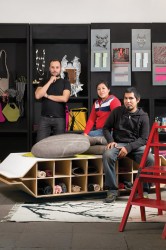An experimental shop in Oaxaca, Mexico, is resuscitating the region’s ancient crafts traditions and bringing indigenous artisans’ designs into the 21st century.
 In 2006, inspired by Oaxaca’s plethora of indigenous communities, who, says industrial designer Gustavo Fricke, “inherit craft traditions that are older than Columbus,” Fricke opened blackbox. To stock the shop, located in a colonial house in downtown Oaxaca city, Fricke and other designers collaborate with local artisans to create stylish, contemporary objects in time-honored ways. By spotlighting native talent—from city and village alike—Fricke and shop managers Roberto Vega and Rosario Martinez Llaguno hope to provide a sustainable livelihood for Oaxaca’s underemployed artists and craftspeople and, as Fricke says, “push their work forward.”
In 2006, inspired by Oaxaca’s plethora of indigenous communities, who, says industrial designer Gustavo Fricke, “inherit craft traditions that are older than Columbus,” Fricke opened blackbox. To stock the shop, located in a colonial house in downtown Oaxaca city, Fricke and other designers collaborate with local artisans to create stylish, contemporary objects in time-honored ways. By spotlighting native talent—from city and village alike—Fricke and shop managers Roberto Vega and Rosario Martinez Llaguno hope to provide a sustainable livelihood for Oaxaca’s underemployed artists and craftspeople and, as Fricke says, “push their work forward.”
Why did you open blackbox?
Each village outside Oaxaca city has a crafts specialty—making black pottery, wool weaving, carving alebrijes [fantastical wooden figures]—and the artisans pass their skills down through the generations. But to cater to tourists’ tastes they started producing the same designs over and over again. I thought it would be interesting to collaborate with these artisans, to use design as a tool for social improvement.
What’s your overarching goal?
To build trust and working relationships with these communities and give them a new channel for their work. I want the younger generation to feel proud of their skills, to realize: “Shit, man, this is cool and I made it. I learned this from my grandpa, and now this is giving me my bread.”
And what’s the biggest challenge?
The indigenous people in Mexico have been betrayed all their lives. It takes time to prove we’re worth their time. They still call me güero, or “blonde”—meaning an outsider.
How has the shop evolved?
It started with 12 products that I designed in collaboration with handcrafters. Now it is open to more local designers, artists, and artisans. I moved to San Francisco in 2008 for graduate school, so Roberto and Rosario, young artists who founded the Lapiztola street art collective, have been running the shop day to day.
How do you define good design?
Good design is when you strip all the designer BS away and you are able to experience the soul of an object.
Can you give an example of a successful collaboration?
I met my favorite artisan, Sergio Lazo, when he was in the city selling his woven wool bags. I went to his village, Teotitlan del Valle, and sat with his family in a circle; it was like having a meeting with a Cherokee chief. I pulled out a blueprint for a rug design–—I had traced the shadows from a tree on a big piece of paper–—and asked, “Can you make this?” I told him I was promising a relationship. They started talking in their indigenous language and then said okay. We’ve been working with his family ever since. Today he’s so proud of his work that he signs every piece he makes. The challenge for us is to create more stories like that.
What’s next for blackbox?
I want to establish a cooperative model of management, to open the responsibility and profit of the store to more people. I’m also designing two new lamps made out of carrizo [a bamboo-like material] for a crafts community in Papalutla, and I’m looking for more ceramic and glass objects to sell.
blackbox
5 de Mayo #412
Oaxaca, Mexico
la-blackbox.com
Where: Oaxaca, Mexico
Who: Gustavo Fricke, Roberto Vega, and Rosario Martinez Llaguno
Specialty: Handmade furniture, clothing, and objects by artists and artisans throughout the state of Oaxaca
Top Seller: Woven wool bags emblazoned with silhouettes of birds and telephone poles, $75
Best Deal: Limited-edition screen-printed posters by local artists, $17
Coolest Find: Chairs made from pipes and fluorescent plastic tubing by architect and artist Joel Gomez, from $100
